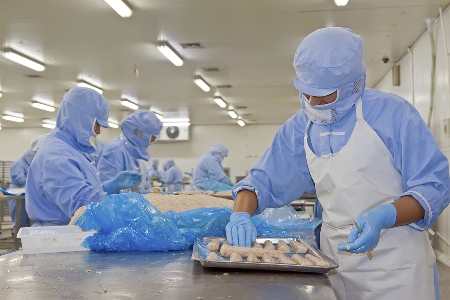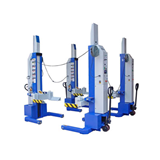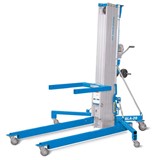Agriculture is one of Australia's most productive industries and our farm output is on the rise. Our food and beverage processing sector is also growing and is now Australia's largest manufacturing sector in terms of employment.
Food and beverage workforce
Australia's food and beverage industry, encompassing agricultural production and food and beverage processing, employs more than half a million Australians and accounts for around four per cent of the nation's gross domestic product. The industry also contributes significantly to Australia's export income, with exports valued at $30.5 billion in 2011–12 (representing 11.5 per cent of total merchandise trade).
While total employment across the industry has fallen in recent decades, the value of production has continued to rise as productivity has improved. Productivity growth will need to be sustained if Australia is to take full advantage of the export opportunities opened by the growing global demand for food - particularly from the emerging middle classes in Asia.
However, the industry faces significant change and challenges. The reality is that with limited potential to grow domestic markets, the future lies in finding new customers in rapidly growing and highly competitive Asian markets.
If we are to capitalise on export opportunities, the industry must attract highly skilled workers and better develop and utilise the skills of the existing workforce.
New technologies and a shift away from small, often family-owned farming operations to more concentrated, capital intensive businesses, are also pushing up demand for skilled workers. And as many farmers approach retirement, the industry needs to ensure existing skills and knowledge are retained and passed on.
A new approach is needed which places more value on skills, training and workforce development, and where industry gets more involved in the provision of education and training.
Future outlook for jobs
Employment projections over the next five years suggest a continued decline in employment in agricultural production and a slight increase in food processing employment.
However, it is likely that these projections do not fully capture the longer term potential growth if Australia secures a substantial share of expanding export markets.
Job openings will also occur as a result of the need to replace workers who leave, including the significant number who are likely to retire over the next decade. The Australian Workforce and Productivity Agency has developed a suite of four scenarios to 2025 which show employment growth in a number of occupations. These include: Livestock Farmers, Production Managers, Agricultural and Forestry Scientists, Bakers and Pastry Cooks, Butchers and Smallgoods Makers and Aquaculture Workers.
Skills to grow the industry
The agricultural workforce has a well-developed culture of informal learning, but both the agriculture and processing workforces have relatively low levels of formal qualifications.
Many workers in regional and rural areas do not have easy access to education and training; and it can be difficult for small businesses to provide funding and time off for training. However, in larger food processing companies there can be significant opportunities and resources for training and workforce development.
To meet future demand, the workforce will need higher level training to develop: entrepreneurial, leadership, management, mentoring and risk management skills; advanced production techniques; and the ability to translate research and development into successful new products.
Individuals will need to acquire adaptable skills which they can use across the food supply chain and be work-ready when they graduate.
For some sectors there will be a shift to higher skill requirements, while in others new technologies may de-skill traditional job roles which will require workers to retrain and re-skill.
For the industry to adapt to change and reach its full potential it needs to foster a culture of structured training and lifelong learning.
Strategies for the future
The Food and beverage workforce study puts forward 13 recommendations to build an adaptive, skilled and innovative agrifood workforce. These recommendations are summarised below.
A coordinated approach to workforce development
Currently there is no single body vested with the responsibility for setting the industry's workforce development agenda, and assigning priorities among the multitude of separate programs and policies.
This is resulting in some duplication and inefficiencies, and means available resources are not being prioritised in the most effective way. It also means that industry advice to government on skills and workforce issues is fragmented.
Attracting and retaining a skilled workforce
Enrolments in food-related courses are not keeping pace with the demand for skilled workers. Potential entrants are often unaware of career opportunities in the industry or have poor perceptions of the working conditions.
The industry suffers an image problem among school students and young people in general. There is a widespread but incorrect perception, for example, that there are only limited opportunities for the rewarding exercise of scientific and technical skills in agriculture and food processing.
Many who wish to enter the industry have not had sufficient exposure to the required maths and science skills or agriculture-related studies while at school to do so.
Developing and using the skills of the existing workforce
With increasing competition in both domestic and export markets, higher skills are required to lift productivity through new technology and innovation.
The challenge is to build the skills base of the agrifood workforce and to increase the proportion of workers with post-school qualifications. However, most food businesses do not have internal specialist workforce development knowledge. This means that activities such as job design, workforce planning and skills development which can improve business productivity and solve workforce problems are often neglected.
Business advisory services provided by government are a good source of information and guidance, but they don't always include workforce development advice. Better integration of workforce development advice into these services would help small businesses to improve their capability in this area.
Employers valuing skills and workforce development Industry stakeholders have indicated that there is a general reluctance in the food industry to view traditional forms of training as an investment in the same way that, for example, the purchase of capital equipment is viewed.
To increase industry involvement in skills training employers need to have a better understanding of the value of training and of the returns on investment from training and workforce development.
Ensuring industry-relevant, quality education and training
Industry stakeholders report that graduates often lack practical skills and are not work-ready. To ensure skills are being developed to meet the needs of industry, greater industry involvement is needed in the design and delivery of courses.
Students, also, are seeking education and training that provides practical experience. This is not unique to the food sector, but it signals a need for more agrifood industry work-integrated learning programs such as apprenticeships, traineeships, internships and cadetships.
Increasing the diversity of the food workforce
Increasing the diversity of the food and beverage workforce is a key strategy to improve the supply of workers in the face of imminent retirements of older workers and to build the resilience of the workforce. It also ensures that there are different approaches to problem solving and decision making within businesses.


-160x160-state_article-rel-cat.png)
-160x160-state_article-rel-cat.png)
-160x160-state_article-rel-cat.png)







-160x160-state_article-rel-cat.png)













